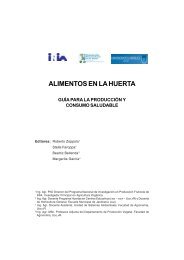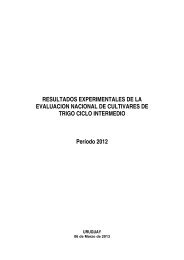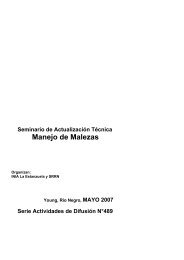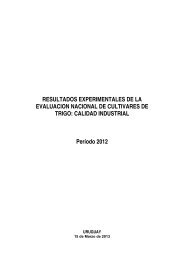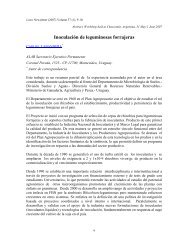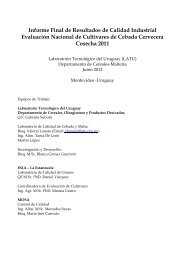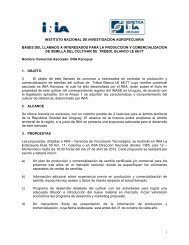Rendimiento de semilla cosechable de Lotus tenuis Waldst et ... - Inia
Rendimiento de semilla cosechable de Lotus tenuis Waldst et ... - Inia
Rendimiento de semilla cosechable de Lotus tenuis Waldst et ... - Inia
Create successful ePaper yourself
Turn your PDF publications into a flip-book with our unique Google optimized e-Paper software.
<strong>Lotus</strong> Newsl<strong>et</strong>ter (2007) Volume 37 (1), 42-45.<br />
Abstract, Workshop held at Chascomús, Argentina, 31 May-1 June 2007<br />
<strong>Rendimiento</strong> <strong>de</strong> <strong>semilla</strong> <strong>cosechable</strong> <strong>de</strong> <strong>Lotus</strong> <strong>tenuis</strong> en respuesta a<br />
la <strong>de</strong>nsidad <strong>de</strong> plantas y al momento <strong>de</strong> cosecha. Avances.<br />
GUSTAVO S. CAMBARERI * , OSVALDO N. FERNÁNDEZ, OSVALDO R. VIGNOLIO y NÉSTOR<br />
O. MACEIRA.<br />
Grupo Agroecología – Unidad Integrada Balcarce, Facultad <strong>de</strong> Ciencias Agrarias<br />
(UNMDP) – Estación Experimental Agropecuaria Balcarce (INTA).<br />
* Corresponding autor<br />
<strong>Lotus</strong> (<strong>Lotus</strong> <strong>tenuis</strong> <strong>Waldst</strong> <strong>et</strong> Kit) es una leguminosa forrajera ampliamente aceptada y<br />
utilizada por los productores gana<strong>de</strong>ros <strong>de</strong> la Pampa Deprimida (Cahuepé, 2004; Coria <strong>et</strong> al.,<br />
2005) por su valor nutritivo, productividad, capacidad <strong>de</strong> resiembra natural y adaptación a<br />
los suelos <strong>de</strong> la región con restricciones por anegamiento y alcalinidad (Montes, 1986;,<br />
Mazzanti <strong>et</strong> al.,1988;, Miñón <strong>et</strong> al.,1990; Vignolio y Fernán<strong>de</strong>z 2006).<br />
Si bien la <strong>de</strong>manda <strong>de</strong> <strong>semilla</strong> <strong>de</strong> L. <strong>tenuis</strong> en Argentina ha sido creciente, la producción <strong>de</strong><br />
<strong>semilla</strong> fiscalizada es muy baja: apenas 17,54 t sobre un área estimada <strong>de</strong> 59 Ha, con un<br />
rendimiento promedio <strong>de</strong> 261 kg <strong>semilla</strong>/ha (INASE, 2005). Distinta es la situación <strong>de</strong> la<br />
<strong>semilla</strong> i<strong>de</strong>ntificada <strong>de</strong> L. <strong>tenuis</strong> cuya producción se estima en 200 t (Maceira <strong>et</strong> al., 2003) y<br />
proviene en su mayoría <strong>de</strong> la cosecha en banquinas y lotes gana<strong>de</strong>ros en clausura (Castaño,<br />
comunicación personal), con producciones que varían entre 25 y 150 kg/ha (Mazzanti <strong>et</strong> al.<br />
1988). Este amplio rango productivo se atribuye a la variabilidad climática, la floración<br />
in<strong>de</strong>terminada característica, el manejo <strong>de</strong> la polinización, el difícil control <strong>de</strong> las malezas, la<br />
falta <strong>de</strong> ajuste en el momento <strong>de</strong> cosecha, la <strong>de</strong>hiscencia <strong>de</strong> las vainas (Carámbula, 1981;<br />
Formoso, 2001; Miñón <strong>et</strong> al., 1990; Montes, 1986).<br />
En los semilleros <strong>de</strong> <strong>Lotus</strong>, el propósito al fijar las <strong>de</strong>nsida<strong>de</strong>s <strong>de</strong> siembra es lograr<br />
poblaciones que permitan el <strong>de</strong>sarrollo <strong>de</strong> plantas vigorosas capaces <strong>de</strong> producir tallos <strong>de</strong><br />
alta fertilidad. Por ello, normalmente estas <strong>de</strong>nsida<strong>de</strong>s son inferiores a las recomendadas<br />
para la producción <strong>de</strong> forrajes (Carámbula, 1981). El obj<strong>et</strong>ivo <strong>de</strong> este trabajo es evaluar el<br />
rendimiento <strong>de</strong> <strong>semilla</strong> <strong>cosechable</strong> <strong>de</strong> <strong>Lotus</strong> <strong>tenuis</strong> en respuesta a la <strong>de</strong>nsidad <strong>de</strong> plantas y al<br />
momento <strong>de</strong> cosecha.<br />
El estudio se llevó a cabo en la Estación Experimental INTA Balcarce (37º 45’ S, 58º 18’ W;<br />
130 m.s.n.m.) sobre un suelo Argiudol Típico (6.65 % M.O., 15.65 ppm P, en los primeros<br />
15 cm <strong>de</strong> profundidad) durante el período septiembre 2006 – marzo 2007. Los tratamientos<br />
consistieron en 3 <strong>de</strong>nsida<strong>de</strong>s <strong>de</strong> (7,14; 14,28 y 57,14 pl/m 2 ) que se arreglaron en un DBCA,<br />
con tres bloques. La siembra se realizó con una máquina experimental a 17,5 cm <strong>de</strong> distancia<br />
entre hileras, posteriormente mediante raleo surco por medio, esa distancia se fijó en 35 cm.<br />
El cultivar <strong>de</strong> lotus utilizado fue Pampa INTA (Gonzalez García, 1998). Se <strong>de</strong>finió una<br />
superficie <strong>de</strong> 12 m 2 (6 m largo X 2 m ancho) para aplicar los tratamientos, que se obtuvieron<br />
por raleos. Se fertilizó con superfosfato triple (18-46-0) luego <strong>de</strong> la siembra para elevar el<br />
42
<strong>Lotus</strong> Workshop, Argentina 43<br />
contenido <strong>de</strong> P a 25 ppm. Las parcelas se mantuvieron libres <strong>de</strong> malezas, insectos y<br />
<strong>de</strong>ficiencias hídricas. Se realizaron cosechas <strong>de</strong> biomasa y <strong>semilla</strong> en ¼ <strong>de</strong> m 2 , en tres<br />
momentos: inicio <strong>de</strong> maduración, plena maduración e inicio <strong>de</strong>hiscencia. Se presentan<br />
resultados <strong>de</strong> las dos primeras cosechas.<br />
70<br />
<strong>Rendimiento</strong> (g <strong>semilla</strong> / m2)<br />
60<br />
50<br />
40<br />
30<br />
20<br />
10<br />
b<br />
a<br />
NS<br />
a<br />
0<br />
Plena maduración<br />
Inicios <strong>de</strong> maduración<br />
0 20 40 60<br />
Densidad (Pl / m2)<br />
Figura 1. <strong>Rendimiento</strong> <strong>de</strong> <strong>semilla</strong> <strong>cosechable</strong> <strong>de</strong> <strong>Lotus</strong> <strong>tenuis</strong> en respuesta a la <strong>de</strong>nsidad <strong>de</strong><br />
plantas y al momento <strong>de</strong> cosecha. L<strong>et</strong>ras iguales entre puntos indican diferencias no<br />
significativas al 5 % (Tukey HSD Test) para un mismo momento <strong>de</strong> cosecha. Las barras<br />
indican el error estándar.<br />
No se registró variación entre tratamientos (p
44 G.S. Cambareri, O.N. Fernán<strong>de</strong>z, O.R. Vignolio, N.O. Maceira.<br />
Bibliografía<br />
CAHUEPÉ M. 2004. Does <strong>Lotus</strong> glaber improve beef production at the Flooding Pampas?<br />
<strong>Lotus</strong> Newsl<strong>et</strong>ter, 34, 38-43.<br />
CARÁMBULA M. 1981. Producción <strong>de</strong> <strong>semilla</strong>s <strong>de</strong> plantas forrajeras. Editorial Agropecuaria<br />
Hemisferio Sur. 516 pp.<br />
CORIA D., LUCESOLI R., MARESCA S., OBREGÓN E., OLMOS G., PETTINARI J., QUIROZ<br />
GARCÍA J. and RÍPODAS I. 2005. Manual para productores gana<strong>de</strong>ros <strong>de</strong> la Cuenca<br />
<strong>de</strong>l Salado. Ediciones INTA. 150 p.<br />
FORMOSO F. 2001. <strong>Lotus</strong> Maku: Manejo, utilización y producción <strong>de</strong> <strong>semilla</strong>s. Serie técnica<br />
119. INIA Uruguay. 69 p.<br />
GONZÁLEZ GARCÍA M. 1998. Pampa INTA un nuevo cultivar <strong>de</strong> <strong>Lotus</strong>. Visión Rural, 51,<br />
33-34.<br />
INASE. 2005. Producción fiscalizada <strong>de</strong> <strong>semilla</strong> forrajera. Génesis. año XVIII nº 57. CSBC.<br />
MACEIRA N., RUIZ O., FERNÁNDEZ O. and VIGNOLIO O. 2003. Generación <strong>de</strong> un producto<br />
diferenciado <strong>de</strong> <strong>Lotus</strong> glaber para el <strong>de</strong>sarrollo sustentable <strong>de</strong> la Pampa Deprimida.<br />
Proyecto INTA PID-FonCyT 350/03<br />
MAZZANTI A., MONTES L., MIÑON D., SARLANGUE H. and CHEPPI C. 1988. Utilización <strong>de</strong><br />
<strong>Lotus</strong> <strong>tenuis</strong> en establecimientos gana<strong>de</strong>ros <strong>de</strong> la Pampa Deprimida: resultados <strong>de</strong><br />
una encuesta. Revista Argentina <strong>de</strong> Producción Animal, 8(5), 357-376<br />
MIÑON D., SEVILLA H., MONTES L. and FERNÁNDEZ O.N. 1990. <strong>Lotus</strong> <strong>tenuis</strong>: leguminosa<br />
forrajera para la Pampa Deprimida. EEA Balcarce, INTA, Argentina. Bol<strong>et</strong>ín<br />
Técnico, N°98, 15 pp.<br />
MONTES L.1986. <strong>Lotus</strong> <strong>tenuis</strong>. Revista Argentina <strong>de</strong> Producción Animal, 8(5), 357-376<br />
VIGNOLIO O.R. and FERNÁNDEZ O.N. 2006. Bioecología <strong>de</strong> <strong>Lotus</strong> glaber mill. (Fabaceae)<br />
en la Pampa Deprimida (provincia <strong>de</strong> Buenos Aires, Argentina). Revisión<br />
bibliográfica. Revista Argentina <strong>de</strong> Producción Animal. 26: 113-130.<br />
VIGNOLIO O.R., FERNÁNDEZ O.N. and MACEIRA N.O. 2002. Biomass allocation to<br />
veg<strong>et</strong>ative and reproductive organs in <strong>Lotus</strong> glaber and L. corniculatus (Fabaceae).<br />
Australian Journal of Botany, 50, 75-82.



